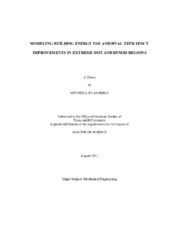Modeling Building Energy Use and HVAC Efficiency Improvements in Extreme Hot and Humid Regions
Abstract
An energy analysis was performed on the Texas A & M University at Qatar building in Doha, Qatar. The building and its HVAC systems were modeled using EnergyPlus. Building chilled water and electrical data were collected to validate the computer simulation. The simulated monthly electricity consumption was within plus/minus 5 percent of the metered building data. Ninety-five percent of simulated hourly electricity data in a day were within plus/minus 10 percent of metered data. Monthly chilled water demand was within plus/minus 18 percent of measurements, and simulated monthly demand was correlated to metered monthly values with an R-squared correlation coefficient of 0.95.
Once the simulation was verified with the metered data, an optimization of the building's HVAC systems was performed. Better utilizing the building's variable speed fans at part loads showed potential annual electricity savings of 16 percent over the base case, with another 22 percent savings in chilled water energy. After converting chilled water savings to equivalent chiller electricity savings, the potential utility cost savings over the base case were found to be $90,000/yr at local utility rates.
Reducing outdoor air intake to ASHRAE indoor air quality minimums yielded an additional 17 percent in potential chilled water savings and brought total monetary savings over the base case to $110,000/yr. Using a dedicated outside air system to precisely control individual zone ventilation showed potential for an additional 12 percent chilled water savings and $14,000 in yearly utility savings, while also eliminating cases of under-ventilation.
A hypothetical retrofit of fan powered terminal units (FPTU's) resulted in energy savings only at very low minimum flow rates, below ventilation standards. Savings were never more than 20 percent over the no-fan case. Series FPTU's showed no savings at any flow setting and negligible difference was found between ECM and SCR motor control.
Finally, the dependence on climate of each improvement was studied. Simulations were run in the relatively milder climates of Houston and Phoenix and compared to those found for Doha. It was found that variable speed fan operation is a more cost effective option for milder climates, while outside air control is more cost effective in extreme hot and humid climates such as Doha. Future study is needed to make the FPTU model valid for different climates and flow ranges.
Citation
Bible, Mitchell (2011). Modeling Building Energy Use and HVAC Efficiency Improvements in Extreme Hot and Humid Regions. Master's thesis, Texas A&M University. Available electronically from https : / /hdl .handle .net /1969 .1 /ETD -TAMU -2011 -08 -10153.


